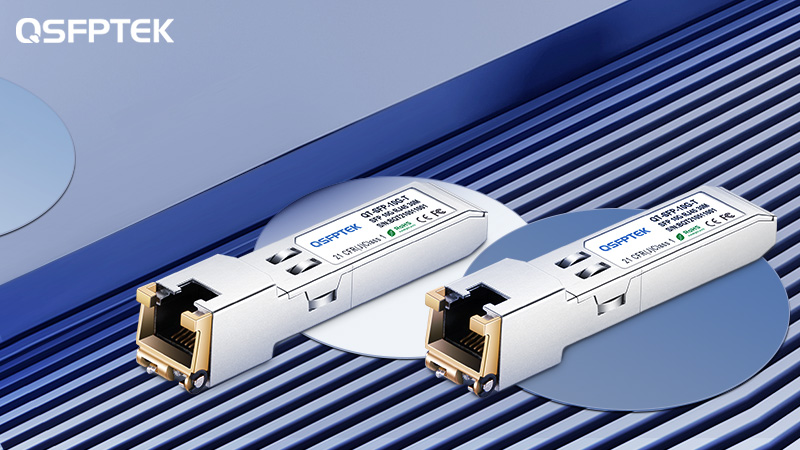When building 10Gbp Ethernet, we need to choose a suitable transmission scheme, and we need to optimize the current infrastructure to maximize performance
Generally speaking, IT technicians have two options for building a 10 Gb Ethernet network: 10GBASE-T and SFP+ solutions (SFP+ fiber/DAC/AOC). The maximum transmission distance of the 10GBASE-T copper module can reach 100m over cat 6a/cat 7 cables. The SFP+ optical module can reach a maximum transmission distance of 300 meters on multimode fibers; on single-mode fibers, its maximum transmission distance can reach 80km. The application range of SFP+ DAC /AOC cable is usually blade chassis or 10GbE in racks over short distances, and the transmission distance is generally 3m 5m 7m 15m to 30m.
What is the Difference Between 10GBASE-T vs SFP+ Fiber vs SFP+ DAC?
In this part, we will introduce the 10GBASE-T module, SFP+ fiber transceiver, and SFP+ DAC in detail
Latency
Low latency can ensure fast network response time and reduce CPU idle cycles, low latency can improve data center efficiency, and further, return on investment. 10GBASE-T copper modules are designed as a PHY standard to allow 10GBASE-T modules to use block encoding to transmit data over copper cables while minimizing bit error rates. The PHY standard specifies 2.6 microseconds for a transmit-receive pair, and the block size requires a delay of fewer than 2 microseconds. Whereas SFP+ uses simplified electronics that require no coding, with a latency of 300 nanoseconds per link. From the figure below, we can see that the delay performance provided by SFP+ fiber is better than the other two
| Number of Links | 10GBASE-T SFP+ | SFP+ Fiber | SFP+ DAC |
| 1 | 2.6 | 0.1 | 0.3 |
| 2 | 5.2 | 0.2 | 0.6 |
| 3 | 7.8 | 0.3 | 0.9 |
| 4 | 10.4 | 0.4 | 1.2 |
| 5 | 13 | 0.5 | 1.5 |
| 6 | 15.6 | 0.6 | 1.8 |
Power Consumption
Comparing these three solutions, the 10GBASE-T solution consumes more power than the SFP+ solution, about three to four times. The power consumption of 10GBASE-T is related to the length of the matching cable, and the power consumption of the cable can be from 2w to 5w, while for SFP+, the power consumption of this solution is the same, both 0.7w. When hundreds or thousands of cables are installed, using SFP+ solutions can save a lot of costs.
Backward Compatibility
10GBASE-T copper supports backward compatibility with other standard copper network equipment, which gives it the advantage of leveraging existing copper structured cabling. Thanks to the use of RJ45 connectors, 10GBase-T ports can be connected to 1 gigabit or even 100 megabit interfaces. The DAC cable can only be used with 10GbE switches and has no backward compatibility. SFP modules supporting 1GBase-T can also be inserted to connect to legacy ports at slower speeds.
Application
Applications for 10GBASE-T SFP+ include wiring closets for switches and patch panels that are connected to a large number of desktop computers via 10GBASE-T SFP+. SFP+ DAC is generally used in the Top of Rack cabinet connection from the server to the ToR switch, limited by the transmission distance, it can only be applied to the connection within 10m. SFP+ modules are often used in campus LANs to connect multiple buildings together, and it has the highest transmission distance of the three.
Conclusion
By comparing the different performances of 10GBASE-T vs SFP+ vs DAC, I believe you know how to choose the right solution. When we choose to build a 10G Ethernet network, we need to choose the right 10GBASE-T vs SFP+ vs DAC. If you don’t know how to choose, you can contact QSFPTEK customer service via sales@qsfptek.com, QSFPTEK provides a series of high-quality and cost-effective optical components including 10GBASE-T vs SFP+ vs DAC.



